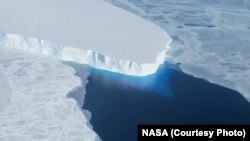A large portion of the West Antarctic Ice Sheet is melting rapidly, and appears to be in an irreversible state of decline. That assessment, from a new study by researchers at NASA and the University of California, Irvine, finds that there is nothing to stop the glaciers in the area from melting into the sea.
Glaciologist and lead author Eric Rignot told a news conference Monday that the melting will be a major contributor to sea level rises in the decades and centuries to come.
"We and many other colleagues have looked extensively at this part of the world over the last two decades, with satellites, airplanes, ships and ground survey. We have examined enough direct and independent observations of this part of the world to conclude that the retreat of ice in that sector is unstoppable," said Rignot.
The glaciers in the Amundsen Sea sector of West Antarctica contain enough ice to raise the global sea level by more than a meter, and are melting faster than most scientists had expected. They already release almost as much ice into the oceans annually as the entire Greenland Ice Sheet.
The report, which appears in the journal Geophysical Research Letters, concludes: "The fact that the retreat is happening simultaneously over a large sector suggests it was triggered by a common cause, such as an increase in the amount of ocean heat beneath the floating sections of the glaciers. At this point, the end of this sector appears to be inevitable." The researchers say while cutting CO2 emissions could slow the glacier loss, they stress it could not reverse it.
For additional images and video related to this new finding, visit: http://go.nasa.gov/1m6YZSf
For additional information on the West Antarctic Ice Sheet and its potential contribution to sea level rise, visit: http://go.nasa.gov/1oIfSlO
Glaciologist and lead author Eric Rignot told a news conference Monday that the melting will be a major contributor to sea level rises in the decades and centuries to come.
"We and many other colleagues have looked extensively at this part of the world over the last two decades, with satellites, airplanes, ships and ground survey. We have examined enough direct and independent observations of this part of the world to conclude that the retreat of ice in that sector is unstoppable," said Rignot.
The glaciers in the Amundsen Sea sector of West Antarctica contain enough ice to raise the global sea level by more than a meter, and are melting faster than most scientists had expected. They already release almost as much ice into the oceans annually as the entire Greenland Ice Sheet.
The report, which appears in the journal Geophysical Research Letters, concludes: "The fact that the retreat is happening simultaneously over a large sector suggests it was triggered by a common cause, such as an increase in the amount of ocean heat beneath the floating sections of the glaciers. At this point, the end of this sector appears to be inevitable." The researchers say while cutting CO2 emissions could slow the glacier loss, they stress it could not reverse it.
For additional images and video related to this new finding, visit: http://go.nasa.gov/1m6YZSf
For additional information on the West Antarctic Ice Sheet and its potential contribution to sea level rise, visit: http://go.nasa.gov/1oIfSlO







